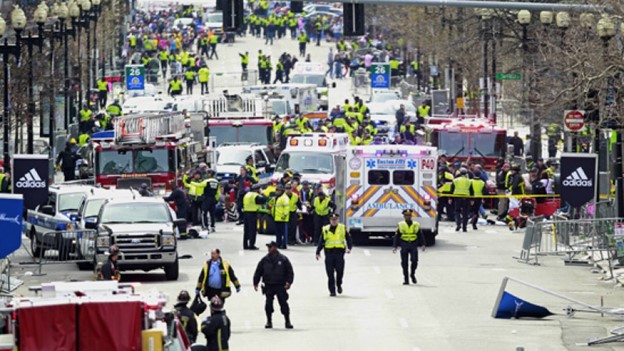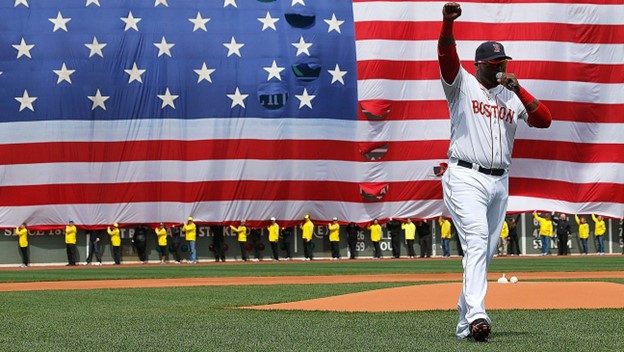Table of Contents
Monday, April 15, 2013. The 117th Boston Marathon began and tens of thousands of runners from across New England, the United States, and the world competed in one of the oldest marathons in the country. At 11:05 AM, the first pitch was thrown to start the game at Fenway between the Red Sox and the Tampa Bay Rays. The runners were making their way along that 26.2-mile course beginning in Hopkinton and ending on Boylston Street in Boston. Crossing the finish line on Boylston Street is not only a moment of pride for the runner, the people in the stands and watching at home take pride in seeing people cross that line. A marathon is no easy feat, and that day would not get any easier.

At 2:49 PM an explosion went off a block away from the finish line at a Marathon Sports. Fourteen seconds later, another explosion went off a block away outside of the Forum restaurant. Three were killed instantly including 8-year-old Martin Richard, along with hundreds wounded. Chaos quickly spread as spectators, runners, and first responders were trying to process what just happened. After recognizing the gravity of the situation, police, firefighters, EMS, and the MA National Guard began to perform lifesaving triage on the victims of the blasts.
While today’s triage is much more advanced, its roots extend to the Civil War. The Letterman System was in full display on that Patriot’s Day. Dr. Jonathan Letterman first introduced his system during the Battle of Antietam on September 17, 1862. 22,000 killed, wounded, missing, or captured resulted from the battle. It became the single bloodiest day in American history and within 24-hours, nearly every wounded Union soldier was off the battlefield and in the care of the Medical Department.

The 10,000 wounded Union soldiers were transported from Sharpsburg to Frederick, MD to one of 27 public buildings used as hospitals. The entire city of Frederick was turned into a hospital overnight and the wounded kept pouring in through October. From Frederick, wounded soldiers were either released back to their regiments, medically discharged, or transported by rail to cities like Baltimore, Washington DC, Philadelphia, and New York City to receive more extended care.
Fast forward over 150 years to the finish line of the Boston Marathon to the immediate aftermath of the two bombs detonating. Along the marathon route, at every mile mark, there is a medical tent. The medical tent at the finish line was immediately turned into a mass-casualty triage center. The first responders at the scene encountered horrific blast-related injuries and maimings. From this triage center, dozens of ambulances from across the city began transporting the wounded to eight hospitals around the city, “one emergency physician told me he’d never heard so many ambulance sirens before in his life.”[1]
Two years ago, I completed an EMT training course and received my National EMT Certification from the NREMT. One of the main tenants of the course was how to manage MCIs, Mass Casualty Incidents, and the procedures surrounding them. It is a skill that I am thankful to have but hope to never need. On that day, every ounce of training was called upon by the medical staff of the marathon as well as all of the doctors, nurses, and medical personnel of Boston area hospitals. Within minutes, patients were already being evacuated and getting into surgical rooms to receive lifesaving care.

The origins of triage begin on the single bloodiest day in American history and was put on full display in Boston on that day. Medically speaking, the eight hospitals patients were performed their duties exceptionally despite overwhelming odds. Due to the preparation of the Boston Marathon organization and the medical plan already established, the only people who were killed in the bombing were those that died in the initial blast. The medical infrastructure on that day, combined with the dedicated efforts of Boston’s medical caregivers saved the lives of over 200 people wounded. A few days later, MIT police officer Sean Collier was shot by one of the bombers in his patrol car. Five days after the bombings, Boston Police Department, MA State Police, and the FBI cornered and captured one of the bombers after a shootout in Watertown, MA that left one bomber dead.
One of the most horrific events in Boston was over and it became time to heal as a city. Two days after the bombings, the Boston Bruins hosted the Buffalo Sabers, the massive crowd at the TD Garden began to sing the National Anthem, waving the flag and showing their support to the victims of the bombing. After a three-game series in Cleveland, the Red Sox came back to Boston where the team honored city and state leadership, as well and local and state police in their efforts to find the bombers. For the rest of the season, a jersey hung in the Red Sox dugout with the number 617, Boston area code, and Boston Strong across the back. A few months later, the Red Sox won the World Series at home for the first time in 97 years against the St. Louis Cardinals. The ensuing victory parade took the team right to the marathon finish line where the trophy and the 617 jersey were placed on the line.

It has been ten years since the Boston Marathon bombing. Even today, the memory of the bombing still lives in Boston. Many of those who run the marathon will run in support of foundations meant to honor the victims. Some of the victims that had to have a limb removed due to the bombing have gone on to run the marathon. All of the victims that are alive today can thank Dr. Jonathan Letterman’s triage system.
About the Author
Michael Mahr is the Education Specialist at the National Museum of Civil War Medicine. He is a graduate of Gettysburg College Class of 2022 with a degree in History and double minor in Public History and Civil War Era Studies. He was the Brian C. Pohanka intern as part of the Gettysburg College Civil War Institute for the museum in the summer of 2021. He is currently pursuing a Masters in American History from Gettysburg College and the Gilder Lehrman Institute.
Sources
[1] Gawande, Atul. “Why Boston’s Hospitals Were Ready.” The New Yorker, April 17, 2013. https://www.newyorker.com/news/news-desk/why-bostons-hospitals-were-ready.


